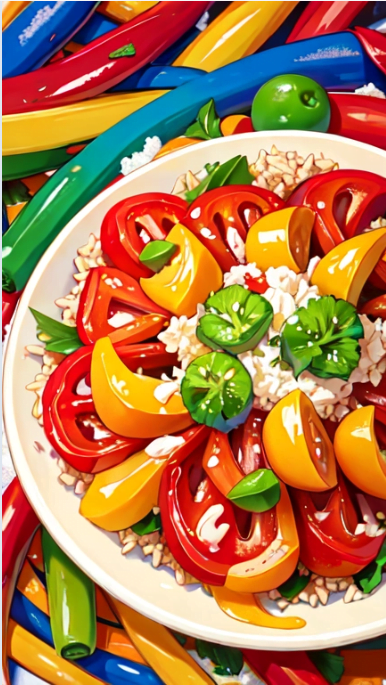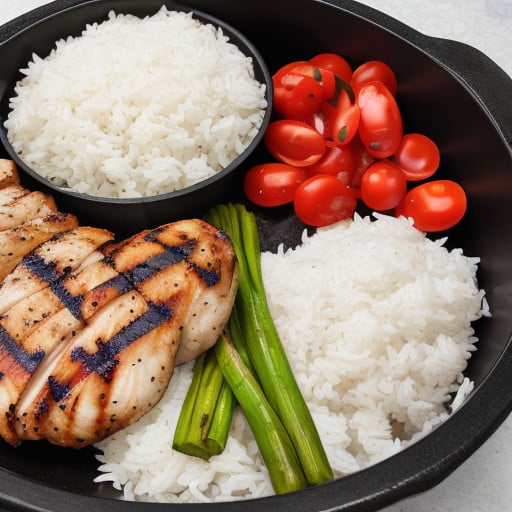There’s nothing quite like the joy of making pizza from scratch with your loved ones. Not only does it offer an opportunity to bond, but it also allows you to customize your pizzas with your favorite vegetables and ingredients. In this blog post, we’ll walk you through a fun, step-by-step guide to making your own veggie pizzas. Whether you’re looking for a weekend family activity or simply want to enjoy a healthy meal, these homemade veggie pizzas are sure to please. Let’s get started!
Introduction
Gathering around the kitchen to create your own veggie pizzas is more than just a meal; it’s an experience. From rolling out the dough to arranging colorful vegetables, making your own pizza is a chance to be creative and enjoy the process of cooking together. Not only can you tailor each pizza to your taste preferences, but you also get to control the quality and quantity of ingredients, making it a healthier option compared to takeout or frozen pizzas.
Step 1: Gather Your Ingredients

The first step in making your own veggie pizzas is to gather all the necessary ingredients. Here’s what you’ll need:
- Pizza Dough: You can either make your own dough from scratch or use store-bought dough. If you’re short on time, many grocery stores offer pre-made dough that’s perfect for a quick pizza night.
- Tomato Sauce: Classic pizza sauce is a must, but you can also use pesto or a white sauce if you prefer. Homemade tomato sauce is easy to make and can be customized with herbs and spices.
- Cheese: Mozzarella is the traditional choice, but feel free to use other cheeses like cheddar, parmesan, or even vegan cheese if you’re dairy-free.
- Vegetables: Choose a variety of your favorite vegetables. Some great options include bell peppers, mushrooms, onions, spinach, cherry tomatoes, and zucchini. Fresh vegetables will add color, flavor, and nutrition to your pizzas.
Ingredient Prep Tips:
- Pre-Cut Vegetables: Slice or chop your vegetables into bite-sized pieces before you start assembling the pizzas. This will make it easier to distribute them evenly over the dough.
- Seasoning: Don’t forget to season your veggies with a bit of salt and pepper to enhance their flavor before adding them to the pizza.
Step 2: Prepare the Dough

The dough is the foundation of your pizza, so it’s important to get it just right. Whether you’re using homemade or store-bought dough, follow these steps to prepare it:
- Flour Your Surface: Lightly flour your countertop or rolling surface to prevent the dough from sticking.
- Roll Out the Dough: Use a rolling pin to roll out the dough to your desired thickness. If you prefer a thicker crust, roll it out less; for a thinner, crispier pizza, roll it out more. You can make one large pizza or several mini pizzas depending on your preference.
- Shape the Dough: Transfer the rolled-out dough onto a baking sheet or pizza stone. If you’re using a baking sheet, lightly grease it or use parchment paper to prevent sticking.
Dough Handling Tips:
- Rest the Dough: If the dough is too sticky or resistant to rolling, let it rest for a few minutes. This will help relax the gluten and make it easier to handle.
- Even Thickness: Try to roll the dough as evenly as possible to ensure uniform cooking.
Step 3: Spread the Sauce

Now that your dough is prepared, it’s time to add the tomato sauce. This step is crucial as it adds flavor and moisture to the pizza.
- Spoon the Sauce: Use a spoon to spread a thin layer of tomato sauce evenly over the dough. Leave a small border around the edges for the crust.
- Adjust the Sauce Amount: You can use as much or as little sauce as you like, depending on your taste preferences. For a lighter pizza, use less sauce; for a saucier pizza, spread it generously.
Sauce Tips:
- Homemade Sauce: If you’re making your own sauce, try adding herbs like basil, oregano, and thyme for extra flavor.
- Alternative Sauces: Experiment with different sauces such as pesto, BBQ sauce, or a garlic cream sauce for unique flavor profiles.
Step 4: Add Cheese
Cheese is a key component of any pizza, providing a creamy texture and rich flavor.
- Sprinkle Cheese: Evenly sprinkle shredded cheese over the sauce. Mozzarella is the classic choice, but you can mix different cheeses or use a dairy-free alternative.
- Layering Cheese: For a gooey, cheesy pizza, add a thicker layer of cheese. For a lighter option, use less cheese.
Cheese Tips:
- Cheese Blend: Try blending different cheeses for a more complex flavor. Parmesan, cheddar, and gouda can add unique tastes.
- Vegan Cheese: If you’re avoiding dairy, there are many great vegan cheese options available that melt well and provide a similar taste.
Step 5: Choose Your Veggies

This is where you can get creative! Select a variety of vegetables to top your pizza. Here are some popular choices:
- Bell Peppers: Add sweetness and crunch.
- Mushrooms: Provide an earthy flavor.
- Onions: Offer a zesty bite.
- Spinach: Adds a touch of freshness.
- Cherry Tomatoes: Bring a burst of juiciness.
- Chop Vegetables: Ensure all vegetables are chopped into bite-sized pieces for even cooking.
- Arrange Toppings: Scatter the vegetables evenly over the cheese. Feel free to get artistic and create patterns or designs with your toppings.
Veggie Prep Tips:
- Pre-Cooking Vegetables: Some vegetables, like mushrooms and spinach, release moisture as they cook. Pre-cook these vegetables lightly to avoid a soggy pizza.
- Seasoning Veggies: Toss your veggies with a bit of olive oil, salt, and pepper before adding them to the pizza for extra flavor.
Step 6: Get Creative with Toppings
This is where you can really make your pizza unique. In addition to vegetables, consider adding other toppings like:
- Olives: For a briny, savory kick.
- Artichoke Hearts: Adds a Mediterranean flair.
- Fresh Herbs: Basil, oregano, or parsley can enhance the flavor.
- Crushed Red Pepper: For a touch of heat.
Topping Tips:
- Balance Flavors: Make sure to balance out the flavors with a mix of savory, sweet, and spicy ingredients.
- Don’t Overload: Avoid overloading your pizza with too many toppings, as it can affect the cooking time and result in a soggy crust.
Step 7: Bake Your Pizza

With all your toppings in place, it’s time to bake the pizza and turn it into a delicious, crispy masterpiece.
- Preheat the Oven: Set your oven to 425°F (220°C). A hot oven ensures a crispy crust and evenly melted cheese.
- Bake the Pizza: Place your pizza in the preheated oven and bake for 12-15 minutes, or until the crust is golden brown and the cheese is bubbly and melted.
- Monitor Cooking: Keep an eye on the pizza to ensure it doesn’t burn. Cooking times may vary depending on the thickness of the dough and the type of toppings used.
Baking Tips:
- Pizza Stone: For an extra crispy crust, consider using a pizza stone. Preheat the stone in the oven before placing the pizza on it.
- Rotate for Even Cooking: If you’re baking multiple pizzas, rotate them halfway through to ensure even cooking.
Step 8: Slice and Enjoy
Once your pizza is baked to perfection, let it cool for a few minutes before slicing.
- Cool Slightly: Allow the pizza to cool for a few minutes to make slicing easier and to prevent burning your mouth.
- Slice: Use a pizza cutter or a sharp knife to slice the pizza into wedges.
- Serve: Serve your homemade veggie pizza with a side salad or your favorite dipping sauces.
Serving Tips:
- Garnish: Add fresh basil or a sprinkle of parmesan on top of the pizza before serving for added flavor.
- Accompaniments: Pair your pizza with a refreshing beverage like sparkling water or a light wine.
Tips for Perfect Veggie Pizzas

To ensure your veggie pizzas turn out perfectly every time, consider these helpful tips:
- Pre-Cook Watery Vegetables: Vegetables like mushrooms and spinach can release moisture during baking, which may lead to a soggy crust. Lightly pre-cook these veggies to reduce moisture.
- Use a Pizza Stone: A pizza stone helps achieve a crispier base and more evenly cooked crust.
- Seasoning: Don’t forget to season your vegetables and the pizza crust with salt, pepper, and your favorite herbs to enhance the overall flavor.
Conclusion
Making your own veggie pizzas is a fun, interactive, and healthy way to enjoy a meal with family and friends. The process of preparing the dough, spreading the sauce, and adding your favorite toppings allows you to create personalized pizzas that cater to everyone’s tastes. Plus, you get to enjoy the satisfaction of eating a homemade meal that’s both delicious and nutritious.
So gather your ingredients, get creative with your toppings, and bake up a batch of homemade veggie pizzas. Whether you’re hosting a family pizza night or just looking for a tasty weeknight dinner, these pizzas are sure to be a hit. Happy cooking!
Feel free to experiment with different vegetables and seasonings to discover your






FinTech ZoomUs I do not even understand how I ended up here, but I assumed this publish used to be great